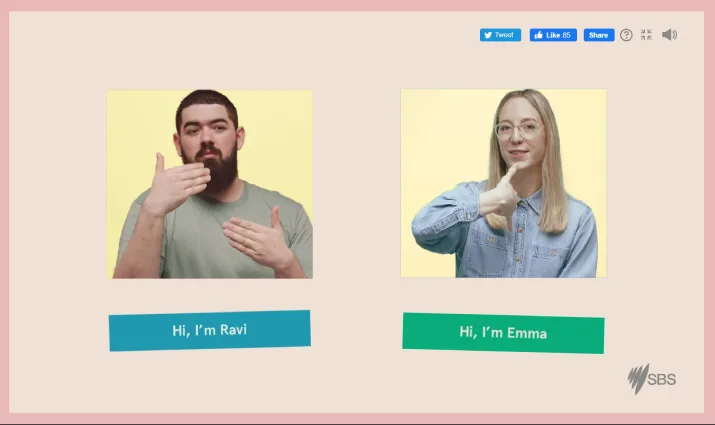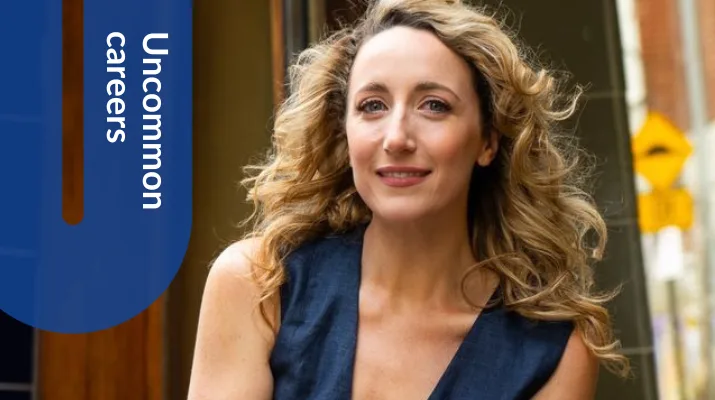What is Auslan? Here are 7 facts to know
By Chloe Cann
It’s a beautiful, complex and creative visual language that uses hand shapes, facial expressions and body language. And no, it’s not just English conveyed through signs.
For most of the hearing world, our only exposure to sign language is through watching live interpreters on the bottom corner of our screens.
So, to help us understand the rich world of Auslan (or Australian Sign Language), we reached out to Ravi and Emma Vasavan. Ravi, an artist and designer, was born Deaf to Deaf parents, and names Auslan as his first language. Emma, Ravi’s partner, who is hearing, started learning Auslan in 2012.

1. Auslan is a completely different language to English
"To put it simply, Auslan is the language used by the Australian Deaf community. It’s a language in its own right, on equal footing with spoken and written English,” says Ravi.
"It has its own grammar, history and culture. It’s not signed English,” adds Emma.
“The term ‘Australian’ signifies its unique regional identity, and Auslan has dialects too,” explains Ravi.
“Many people ask whether sign languages are the same across the world. When they realise that they’re not, they ask if they should be. I’m always shocked—language is an incredible part of our respective cultures and histories. Why would we want to simplify that?” Emma continues.
2. There are heaps of sign languages globally and in Australia
Worldwide, there are around 300 known sign languages—meaning there could be many more that haven’t yet been counted as such. But we don’t have to travel very far to see how diverse sign languages are.
“Before going into more detail about Auslan, I want to acknowledge that Aboriginal sign languages exist and have been used for 65,000 years,” states Ravi.
Jody Barney, a Deaf Aboriginal woman from Queensland, says, “I know of about 55 sign languages connected to Aboriginal spoken languages nationwide, but there’s probably more.” She is fluent in an astonishing 18 Indigenous sign languages.
Related: Indigenous language courses
Within Auslan, there are two main dialects—a Northern (used in New South Wales and Queensland) and Southern (used in Victoria, South Australia, Western Australia and Tasmania) dialect.
“The regional differences are nuanced and not drastically different to what you might experience with spoken languages. You can often grasp the meaning of unfamiliar signs by building context around them, just like you’d adapt to different accents and colloquialisms in English,” Ravi elaborates.
3. Sign languages, including Auslan, can vividly illustrate concepts that spoken languages can’t
Ravi says that he is fascinated by sign languages’ ability to scale things up and down in a literal sense, using abstraction and visuals. He clarifies that this quirk is not limited to Auslan.
“For instance, we can establish the scale of an object realistically, and if we want to introduce something beyond our comprehension, scale-wise, we reset the ‘scene’ by literally scaling down the first item to the size of a grain of rice between our index finger and thumb, then illustrate the second item. It’s similar to how videos illustrate scale, like this one,” he says.
4. In Auslan, body language and expression play a big role in conveying meaning and emotion
Ravi brings our attention to the word ‘what’ in English.
“When spoken, ‘what’ can be expressed in dozens of ways by changing the cadence, inflection or even drawing out a letter or two. A similar diversity exists in Auslan. For example, scrunching up your face, opening your mouth wide, and dropping your shoulders while signing 'what' signifies a very specific tone of the word. This approach can be applied to almost every word in Auslan, but with the added dimension of more visual parameters to play with.”
Reflecting on the start of her Auslan-learning journey, Emma talks about the initial hurdle of using her hands, body and face in conversation.
“We don’t do it a lot as hearing people. You’ll feel a bit awkward and make mistakes, not fully knowing how to express something. But if you try to throw yourself in and be okay with those mistakes, you’ll learn so quickly. And everyone is understanding of mistakes,” she says.
So, is it hard to learn Auslan?
Yes and no. With free TAFE courses in Auslan available in Victoria, starting to learn Auslan is easy.
“However, achieving fluency is the real challenge. Just like any spoken or signed language, mastering Auslan takes years of dedicated practice and immersion,” Ravi tells us.
According to Emma, “I would say it took a year to build a certain level of confidence and knowledge, but in that year I was still using it all the time and building connections and relationships…you’ll be amazed at how you can find new ways to express yourself.”
Related reading: How long does it take to learn a language?
However, she thinks that improving her facial expressions are an ongoing effort.
“It’s an integral part of every sign, and as a hearing person I just couldn’t express the nuance of things well (in the beginning). I struggled to connect to what I was expressing, and how to adjust or push those expressions more,” she explains.
Emma continues with, “I’ve been signing for 11 years now. In that time I’ve become a lot more expressive, both in my use of Auslan and more broadly when I speak, but there’s plenty for me to learn.”
5. Auslan is constantly evolving
Auslan signers create or borrow signs all the time, just like in spoken languages.
“Pop culture plays a significant role—trends often emerge organically from a small group of friends or an individual who is a fan of something or someone. These expressions are then used within their circles. While some linguistic trends are fleeting, others endure and become more widely adopted,” says Ravi.
Auslan signs are influenced by each succeeding generation. Some can start out hyperlocal in nature—like from students attending a specific school. Realistically, any social group is a potential source of new signs.
“Gen Z, in particular, is infusing Auslan with their own distinct flavour, shaped by their unique experiences, both offline and online,” he says. “I don’t interact with many Gen Z individuals on a daily basis, so if I found myself in a room with them discussing undeniably Gen Z content, I might be a step behind in understanding context-specific signs. Fortunately, I’m a ‘very online’ person, so I can usually catch up and understand these signs within their context.”
So, how best to learn Auslan?
Emma weighs in on both informal and formal learning.
“Everything I know in Auslan is learnt from friends, family, friends of friends, travels… I think that means I have a really conversational nature to my signing—not always super sharp and clear and likely not always grammatically perfect, but all of it flows along okay for how I use it—which is all with friends and family,” she says.
You could always start with the Auslan alphabet—the first thing Ravi taught Emma early on when they met.
Related: Auslan courses
Ravi describes why. “It’s essential for asking questions like What is the sign for…? From there, I usually focus on areas of mutual interest, such as art or food. This lets you learn the language in a relaxed manner, focusing less on structure, more on natural communication.”
On the other hand, Emma says, “I’ve had family and friends take more formal classes, and it’s given them great foundations—particularly in grammatical rules and structure.”
6. Deaf people generally rely on Auslan interpreters in their day-to-day
Ravi tells us that, “For quick, on-demand needs, such as calls and in-person conversations, I use Convo’s virtual interpreting service (VIS). For projects with my own clients, I prefer to work with a select group of interpreters who are well-versed in the specific language and vernacular relevant to my work (in design and art direction).”
He says that it can take at least a week, sometimes up to a month, to book his preferred interpreters.
“These professionals are familiar with my work and communication style, providing invaluable context and understanding. Being fluent in English and other languages, I can nearly level the playing field with my hearing counterparts—but this is only possible with the right interpreters who can articulate my thoughts as if they were their own.”
“Unfortunately, finding such a high level of interpretation is a rare occurrence,” he continues.
Is there a demand for Auslan interpreters?
Definitely. The Australia Census Explorer shows that around 16,000 people in Australia use Auslan. However, there are only 302 active interpreters in service around the country.
“Fields such as the arts and medicine often have Deaf professionals who face a shortage of interpreters with expertise in their areas,” Ravi explains.
If you’re interested in becoming an interpreter, keep these in mind:
Get deeply involved in the Deaf community
Says Ravi, “This hands-on experience is the fastest, most reliable way to become skilled, complementing (not replacing) formal, accredited education.”Specialise in a particular niche
“By focusing on underserved sectors, you can advance your career and provide invaluable support to those at a disadvantage,” he advises.Adapt to your client
“Interpreters must be adept at keeping up with my natural signing pace and language use. It’s essential that they adjust to my communication style, rather than expecting me to modify mine to suit their receptive abilities,” says Ravi.
He continues with, “This ability to read and interpret my signs and those of others accurately and swiftly is a key component of effective interpretation and seamless, authentic communication.”
7. Check out these Auslan courses (and resources)
If we’ve made you more curious about Auslan and Deaf culture, here’s a list of people, places, performances (and more) to explore. Good luck on your learning journey!
Try signing Auslan for the first time
Ravi & Emma—an interactive documentary detailing how our two interviewees met and fell in love! Created in collaboration with SBS.
Courses
Community courses (a.k.a. non-accredited courses) by organisations like Deaf Connect, Expression Australia.
DeafNav publishes a list of community and accredited courses across Australia. You can also study single Auslan subjects online through us with La Trobe University.
Ravi and Emma stress that it is a must to seek courses led by Deaf teachers who are active in the Deaf community.
Visual and participative arts
Personal, a multimedia solo performance by Jodee Mundy, about growing up as the only hearing person in a Deaf family.
Imagined Touch documentary by Sofya Gallan and Jodee Mundy, about two deafblind women who turned a small community performance into a sell-out success at the Sydney Festival.
SPIN, a different kind of dance rave by Anna Seymour, a Deaf dance artist and performer, 17-22 January at the 2024 Sydney Festival.
Books
The Shape of Sound by Fiona Murphy, in which she explores her experiences with Deafness and disability.
The Invention of Miracles by Kate Booth, about Alexander Graham Bell and how he tried to suppress American Sign Language, promote oralist education and wage war against Deaf culture.
Videos
Auslan—Overview of History, Linguistics and the Deaf Aussie Community by The Sign Polyglot
@openthatdoor__, by Hadley Johnson, a brilliant Deaf creator and Auslan teacher who also hosts hangouts where you can practise signing.
@auslanrocks, by Melissa Bryson, a Deaf teacher with content aimed at kids.
@deafaboriginalservices, an organisation founded by Joanna Agius OAM, a Deaf Narungga woman, that provides culturally appropriate interpreting, translating, educational and advisory services.
Explore the Auslan courses that are available online through Open Universities Australia. Or browse other online language courses taught by leading universities.
Get personalised advice about online study
A student advisor will call you at your preferred time to answer your questions.



